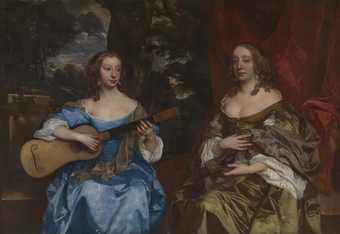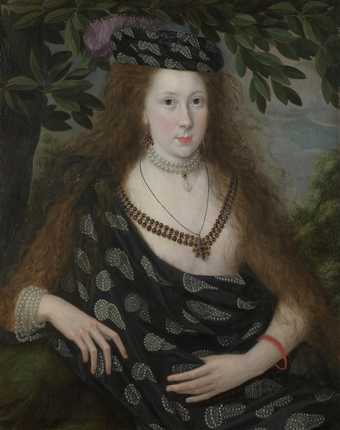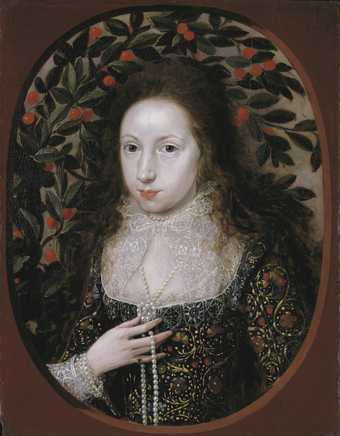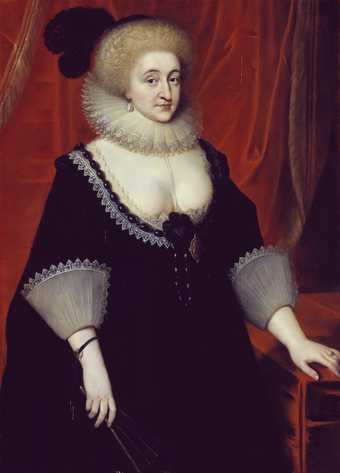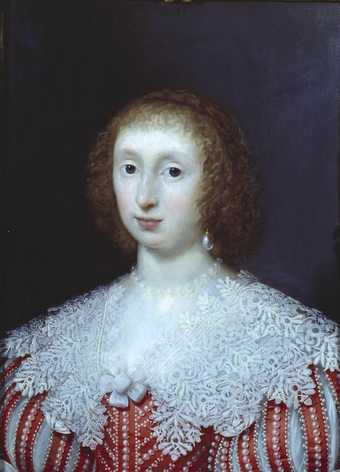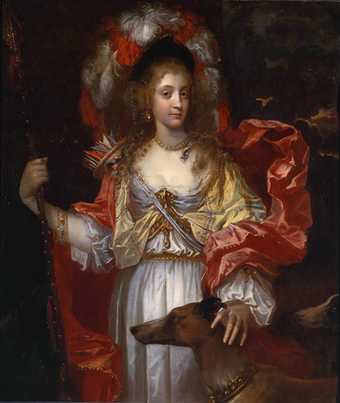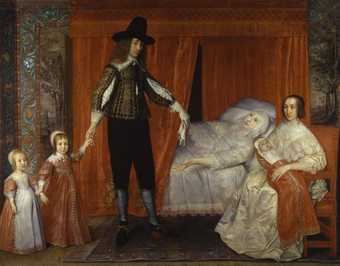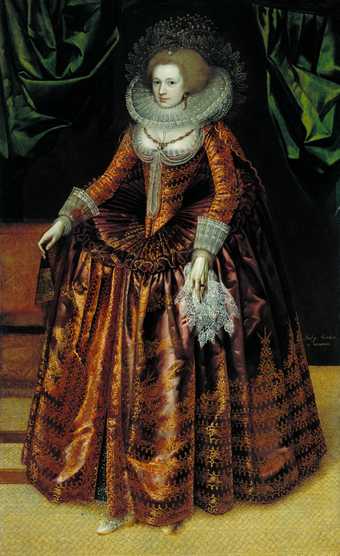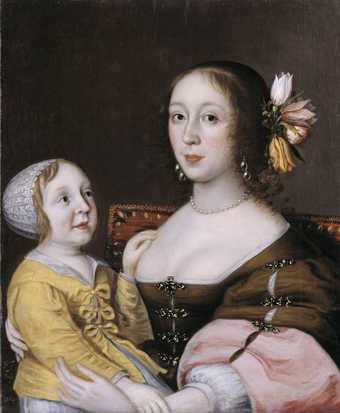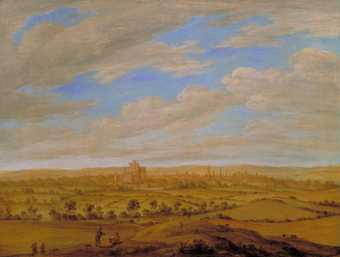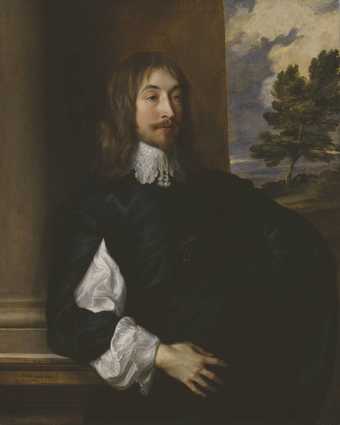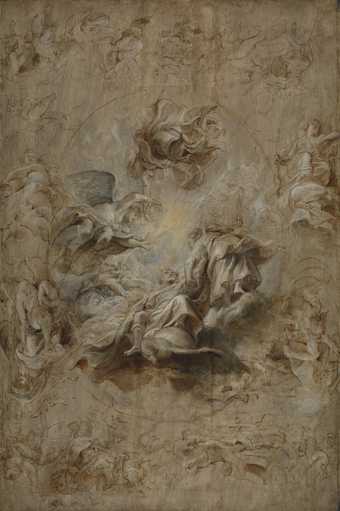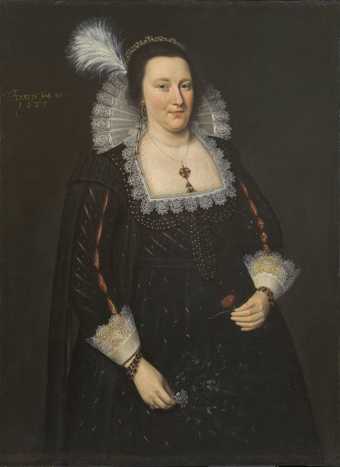
In Tate Britain
- Artist
- Sir Anthony Van Dyck 1599–1641
- Medium
- Oil paint on canvas
- Dimensions
- Support: 2076 × 1276 mm
- Collection
- Tate
- Acquisition
- Purchased 1977
- Reference
- T02139
Summary
Painted during the 1630s, this is the type of full-length portrait by van Dyck that was to influence subsequent English portrait-painters from Thomas Gainsborough (1727-88) to John Singer Sargent (1856-1925). This image of a young woman in a blue satin gown was recorded at Althorp, Northants, the family seat of the Earls of Spencer, in the early eighteenth century, although knowledge of the identity of the sitter had by then been lost. Sir Oliver Millar has recently tentatively suggested that she could be Elizabeth (1618-72) daughter of William, 2nd Lord Spencer of Wormleighton (1592-1636).
Alongside the subject, a small brown-and-white spaniel jumps up at a lizard which clings to the heavily rusticated pedestal of a large urn. Both creatures can be seen as symbols of fidelity, and would thus be appropriate inclusions in a portrait of a recently betrothed or newly married woman. In 1634, Elizabeth Spencer married, as her first husband, John, 1st Lord Craven of Ryton (1610-48) and the portrait could therefore have been painted at around that time. The portrait was complete by 1639, when Wenceslaus Hollar (1607-77) used it as the basis for an engraving in his set of English costume studies Ornatus Mulieribus Anglicanus, which was published in 1640 with the plates individually dated (reproduced Cumming, p.65, fig.60).
When the German art historian Dr Gustav Waagen saw this painting at Althorp in 1835, he observed that 'The action of walking, and the gambols of a little dog, give much life to the picture. It has unfortunately been rather injured by cleaning' (G.F. Waagen, Works of Art and Artists in England, London 1838, vol.3, p.335). It was acquired in 1977 by the Tate Gallery, which had not until then possessed any work by van Dyck. Its carved and gilded surround is of the type known as a 'Sunderland frame', many examples of which were and are to be found in the Spencer family collection. The frame could not originally have been made for this work, however, because it is a little too large, necessitating the addition, at an unknown date, of flat wooden strips within the inner edges to cover the edges of the canvas.
Born and trained in Antwerp, van Dyck became an assistant there to the great international artist, Sir Peter Paul Rubens (1577-1640). Van Dyck first visited England from November 1620 to February 1621, when he painted a handful of works. From late 1621 to late 1627, he was in Italy, where he absorbed the techniques and compositions of such recent Venetian painters as Titian (c.1487-1576). In 1632, van Dyck entered the service of the British king Charles I (reigned 1625-49) who knighted him the same year. Van Dyck single-handedly transformed the portraiture of the king, his family and the Court. He died in London in 1641, his early death perhaps brought on by overwork.
A version of this picture by an unknown artist , but with a different head and facial features and identified as 'Lady Gerard of Bromley', was formerly in the collection of the Earls of Westmoreland; it was sold at Christie's, London, on 20 June 1975, lot 43, and again on 11 June 1999, lot 11.
Further Reading
The Tate Gallery 1976-8: Illustrated Catalogue of Acquisitions, 1979, pp.2-5
Valerie Cumming, A Visual History of Costume in the Seventeenth Century, London 1984, pp.64-5, reproduced p.64
Masterpieces of British Art from the Tate Gallery, exhibition catalogue, Tokyo Metropolitan Art Museum and Hyogo Prefectural Museum of Modern Art Kobe 1998, cat. no.4, p.114, reproduced in colour
Karen Hearn
May 2001
Does this text contain inaccurate information or language that you feel we should improve or change? We would like to hear from you.
Display caption
We don’t know exactly who this woman was. The dog and the lizard it is chasing are symbols of fidelity, which suggest she may have been engaged or newly married. Van Dyck was born and trained in Antwerp. He worked in Rubens’s studio and travelled in Italy, studying the work of Titian, before moving to London in 1632. In the same year he was knighted and appointed Charles I’s Principal Painter. His portraits gave his royal and aristocratic sitters an unprecedented glamour and elegance and had a profound influence on the course of British portraiture.
Gallery label, February 2010
Does this text contain inaccurate information or language that you feel we should improve or change? We would like to hear from you.
Catalogue entry
T02139 A LADY OF THE SPENCER FAMILY c.1633–38
Oil on canvas, 81 3/4 × 50 1/4 (206 × 126)
Purchased (Grant-in-Aid) 1977
Prov: ...? seen by George Vertue at Althorp in 1732; recorded by Horace Walpole at Althorp in 1760; the Earls Spencer by descent, until accepted by the Commissioners of Inland Revenue in part satisfaction of Capital Transfer Tax; acquired by the Tate Gallery by reimbursement of the National Land Fund 1977.
Exh: BI 1856 (58); Van Dyck, Grosvenor Gallery 1887 (98); Van Dyck Tercentenary, Antwerp 1899 (76); Flemish Art, RA 1927 (157); Pictures from Althorp, Agnew's 1947 (14); Flemish Art, RA 1953/4 (159); Van Dyck, Agnew's 1968 (46).
Lit: T. F. Dibdin, Aedes Althorpianae, 1822, p.249; J. Smith, A Catalogue Raisonné of the Works of the most eminent Dutch, Flemish and French Painters, 1831, III, p.139, no.501; G.F. Waagen, Works of Art and Artists in England, 1838, III, p.335; Catalogue of the Pictures at Althorp, privately printed 1851; L. Cust, Anthony Van Dyck, 1900, pp.126, 283, cat. no. 187; E. Schaeffer, Van Dyck, 1909, repr. p.410; R. W. Goulding, ‘Wriothesley Portraits’ in Walpole Society, 1920, VIII, p.68, repr. pl.XXXVII; Horace Walpole, ‘Journals of Visits to Country Seats’ in Walpole Society, 1928, XVI, p.33; G. Gluck, Van Dyck, 1931, p.574, repr. p.484; George Vertue, ‘Notebooks IV’ in Walpole Society, 1936, XXIV, p.38; K. Garlick, ‘The Earls Spencer’ in Great Family Collections, 1965, p.201, repr.p.202; J.D. Stewart, ‘Pin-ups or Virtues? The Concept of the “Beauties” in Late Stuart Portraiture’, William Andrews Clark Memorial Library, University of Los Angeles, 1974; Barry Wind, review of above in Seventeenth Century Notes, Winter 1976, p.105; K. Garlick, ‘Catalogue of Pictures at Althorp’ in Walpole Society, 1976, XIV, p.20, cat.no 147, repr.pl.4.
The painting shows a young woman in a pale blue silk dress with red waistband and bows, apparently moving across a carpeted terrace to the right and looking back over her shoulder. Beside her a small brown and white spaniel jumps up at a lizard that is clinging to the heavily rusticated pedestal of a large terracotta ‘Testa di Pan’ urn. Into this trails a spray of greenery with large leaves that could be a painterly rendering of a fig or a vine. Behind her is a russet ‘Vandyke’ curtain draped against a fluted column, and more rusticated masonry. Her jewellery consists of double-stringed pearl bracelets, a pearl necklace, pearl drop ear-rings and plain diamond ornaments in her hair and in the red bow on her corsage.
The identity of the sitter remains obscure and it is not known when the portrait entered the Althorp collection. The earliest reference to it could be George Vertue's note, made during his visit to Althorp in 1732, on the portrait there ‘of a Lady Southampton by VDyke at length [sic]’; he had already accounted for the only other Southampton female full-length by Van Dyck in the collection, the portrait of Rachel de Ruvigny ‘with ye Globe at her feet’ (now in the Fitzwilliam Museum, Cambridge), and the traditional association of T.2139 with the Wriothesley family lends some weight to this supposition.
There is no portrait with which one could identify the picture in the vague 1746 and 1750 Althorp inventories (Garlick, 1976, publishes all the Althorp inventories) except possibly ‘A Lady whole length a Replica by Vandyck’ mentioned in the earlier list as hanging in the Gallery, and which in turn could be ‘A Lady unknown whole length by Van Dyke’ that, according to the second list, was still hanging in the Gallery in 1750. There can however be no doubt that it was T.2139 which Walpole saw when he visited Althorp in 1760 and noted a ‘Lady Spencer, whole length, in blue, Vandyke’, but he does not say where it was hanging. By the time the 1802 inventory came to be drawn up a determined effort seems to have been made to give a firm identity to all the portraits at Althorp, and this picture can be identified with the ‘Penelope Lady Spencer, ye second Lord Spencers Wife - Vandyke’ that was listed as hanging in the Picture Gallery. This name remained with the picture, with some doubts, until its recent sale.
Bearing in mind that the portrait must have been painted between 1633 (although Van Dyck began working in England in 1632, most of the first year was taken up with royal commissions) and 1639, when Wenceslaus Hollar based on it an engraving for his English costume studies (Ornatus Mulieribus Anglicanus, published 1640, with individual plates dated 1638–1640), one has to submit that Penelope Wriothesley (1598–1667), daughter of the 3rd Earl of Southampton, who was expecting her thirteenth child at the time of her husband's death in 1636, seems an unlikely candidate on grounds of age alone. It would seem more reasonable to assume that the young woman in the picture is a member of the Spencer family, or one allied to it, of the succeeding generation. Stylistically the painting seems very close to the portrait of Anne Carr, Duchess of Bedford (1615–84), which still hangs at Woburn and is thought to have been painted around the time of her marriage in 1637. The Tate picture seems to be of someone in the same age group, but it is difficult to offer any suggestions as to who it might be, as portraits were entering the Althorp collection from many related families throughout the seventeenth and early eighteenth centuries.
Apart from the already mentioned 1639 engraving by Hollar, there was a small drawing based on this picture at Wotton, ascribed to John Evelyn (Christie's 14 June 1977, lot 156, repr.; pencil, pen and grey wash, 5 3/8 × 2 1/2ins.; inscribed ‘After V. Dycke’ and numbered ‘20’). The suggestion that it is after the Hollar engraving is not acceptable, as the drawing is in the same sense as the picture, while the engraving is in reverse. Hollar also made minor alterations, like placing the bow on the waist band on the other side of the body, while in the Evelyn drawing it remains half-hidden by the arm, as in the original picture. It is known that Evelyn admired the Van Dycks in Lady Sunderland's collection and he mentions in his diary in 1667 several that later ended up at Althorp, but the Tate picture cannot, unfortunately, be recognised among them.
Some pentimenti are visible where the outline of the dress has been adjusted along the left hand side, and there is some reshaping around the head: originally the hair was fuller on the right hand side of the head, and a long tendril of hair cascaded down the right shoulder. When Dr Gustav Waagen saw the painting at Althorp in 1835 he commented that ‘The action of walking, and the gambols of a little dog, give much life to the picture. It has unfortunately been rather injured by cleaning’. Recent cleaning has revealed that this damage was superficial and that the painting has a lightness and quality that is compatible with Van Dyck's own hand. Much of drawing must have been obscured in Waagen's time, since he does not mention the unusual feature of the lizard on the pedestal which is the object of the dog's gambols.
By this time the rather literal, even punning, symbolism inherited from the Elizabethan period had given way to much more loosely elegant baroque motifs that could be expressed in really painterly terms. Thus while the motif of the dog chasing the lizard is used in a painterly way to animate the picture, it is unlikely to be mere genre. In the absence of any real clue as to the identity of the sitter it is difficult to suggest an exact interpretation. Lizards have been used as symbols of death, but Professor Douglas Stewart has pointed out, in a letter to the compiler, examples of the lizard as emblematic of ‘a creature which is shy, or cool, in love, but constant’ in the Italian Baroque, with which Van Dyck could have been familiar. He suggests that it ‘would be entirely typical of Van Dyck to make the symbolism “active”, i.e. bring out the shyness of the lizard by showing it chased by a dog’. This theory fits well with current ideas on natural history: to judge from the description given in E. Topsell's popular The History of Serpents (1608, p.203), Van Dyck has painted the common European ‘vulgar Lyzard’ very exactly, but he may have thought in terms of the Italian green lizard, or gez, which Topsell describes as ‘a beast very loving and friendly unto man, and an enemy unto all Serpents. For if at any time they see a man, they instantly gather about him and laying their heads at one side with great admiration behold his face’. They were even supposed to fight serpents in the defence of man, and to follow him shyly when he went out for a walk in order to ‘behold his person’. The artist could well have regarded this popular tradition as applicable to all harmless common lizards and included it in the composition in the form of an affectionate creature, so rapt in admiration of the sitter that it even ignores the onslaught of the dog-itself an ancient symbol of faithfulness.
A version of this painting, originating from the collection of the Earl of Westmorland, and certainly not by Van Dyck, was sold at Christie's, 20 June 1975 (43) as ‘Lady Gerard of Bromley’.
Published in:
The Tate Gallery 1976-8: Illustrated Catalogue of Acquisitions, London 1979
Explore
- clothing and personal items(5,879)
- curtain(250)
- urn(52)
- actions: postures and motions(9,111)
-
- standing(3,106)
- woman(9,110)
- Spencer(1)
- individuals: female(1,698)
- sex and relationships(833)
-
- marriage(392)
You might like
-
Sir Peter Lely Two Ladies of the Lake Family
c.1660 -
Attributed to Robert Peake Lady Elizabeth Pope
c.1615 -
Robert Peake Lady Anne Pope
1615 -
Paul Van Somer Lady Elizabeth Grey, Countess of Kent
c.1619 -
Cornelius Johnson Portrait of an Unknown Lady
1629 -
Jacob Huysmans Portrait of a Lady, as Diana
?c.1674 -
David Des Granges The Saltonstall Family
c.1636–7 -
Unknown artist, Britain Portrait of Anne Wortley, Later Lady Morton
c.1620 -
Gilbert Jackson A Lady of the Grenville Family and her Son
1640 -
Marcus Gheeraerts II Portrait of a Woman in Red
1620 -
Alexander Keirincx Distant View of York
1639 -
Sir Anthony Van Dyck Portrait of Sir William Killigrew
1638 -
Sir Anthony Van Dyck Portrait of Mary Hill, Lady Killigrew
1638 -
Sir Peter Paul Rubens The Apotheosis of James I and Other Studies: Multiple Sketch for the Banqueting House Ceiling, Whitehall
c.1628–30 -
Adam de Colone Portrait of Lady Margaret Livingstone, 2nd Countess of Wigtown
1625

